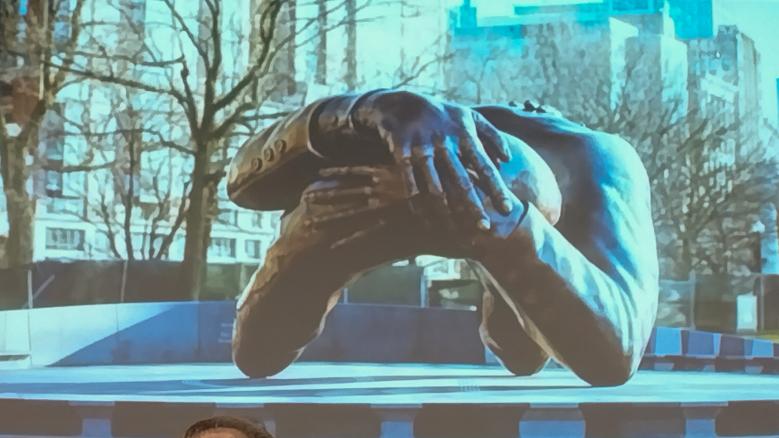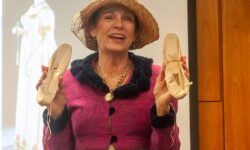By Audrey Anderson
Hometown Weekly Reporter
Imari Paris Jeffries, Ph.D., president and chief executive officer of Embrace Boston, spoke at the Needham Free Public Library as part of Needham’s Black History Month observance. In his presentation, he explained the guiding principles behind the selection of the 20-foot-high bronze sculpture on Boston Common that commemorates the love and partnership between Coretta Scott King and Martin Luther King.
At the outset of his talk, Jeffries described cereal boxes he saw when visiting Mexico that had tape obscuring the cartoon logos meant to catch children’s attention. The cartoons on cereal, candy, and cookie boxes are what children associate with tasty treats. He called them “analog cookies.”
The standard monument in American has long been created in a neoclassical style. A pediment raises the subject of the monument above the people, so they cannot touch it, and so they must raise their eyes to view it. The celebrated person is above the people and out of reach. This kind of monument has long been the “analog cookie” for people we admire as a society.
Famous sculptures, paintings, and other cultural touchstones teach people what a society values; they are also “analog cookies.” Some of the existing ones are no longer relevant to our society. A list of people currently memorialized the most frequently includes national leaders such as Abraham Lincoln, George Washington, and Martin Luther King, but it also includes Robert E. Lee, Confederate military leaders, and Nathan Bedford Forest, the founder of the KKK. A painting of the First Thanksgiving shows a Native American bowing to the pilgrims and welcoming them to America. Monuments in the South glorifying Confederate military and leaders are now being taken down. How should modern monuments look, and what should they teach about our society?
In choosing the form and style of the Martin Luther King monument, the committee chose a new, abstract style of monument that would be on the level of the viewers. They would be able to get close to it and touch it. They would be able to stand inside it. The new monument would be a new kind of “analog cookie,” one that signifies something larger than one person’s actions. According to Jeffries, it would “be a memorial of survival, belonging and love,” and it would “focus on values, not on an individual.”
Jeffries explained that five abstract, modern designs were chosen as finalists by the committee, and the people voted for The Embrace by artist Hank Williams Thomas. Eight industrial 3D printers were used to create the memorial. Multiple smaller pieces were welded together. A bronze finish was chosen for the monument’s design to be compatible with other existing historical monuments in Boston and also for affordability, because of the pandemic material shortage and resulting inflationary pricing.
Embrace Boston’s current activities include a research and policy center and building a museum and cultural center in Roxbury.
In their comments at the end of the presentation, audience members thanked Jeffries for all they had learned and for coming to Needham to share the details of the selection and design process of The Embrace.























